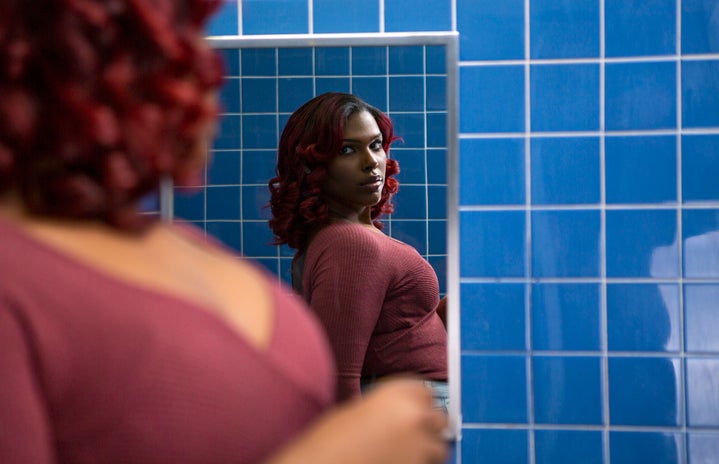Gen Z has grown up in a society that emphasizes adhering to the binary. On the topic of gender or sexuality, children are taught from a young age what box they are expected to fit into. In reality, most young people today identify with some portion of the LGBTQ+ community. Specifically, many of them identify as bisexual, meaning they experience emotional, sexual or romantic attraction to more than one sex or gender. If this is the case, why do bi people face such high levels of public and personal scrutiny? These internal convictions can be categorized as internalized biphobia.
Coming to terms with my bisexuality in high school was an awakening for me. It was like all of the confusion I felt as a child was finally being put into words — that word was bisexual. However, it was a long road to get to that point, and especially to where I am now. Growing up, I didn’t really know what it meant to be gay. It wasn’t something that people talked about around me, so I don’t remember actually knowing about the LGBTQ+ community until middle school. Even then, people really only threw around the terms “gay” or “lesbian.” Judging by the way it was talked about, I didn’t think you were allowed to like more than one gender. So when I felt differently from this norm, I thought there must be something wrong with me, and others wouldn’t want to be around me anymore if they found out.
However, as time progressed, I became more and more accepting of myself and my emotions. I began realizing that many of my friends identified as something other than straight, which helped me learn that there was a community full of people who felt the same way I did. By sharing my experiences with others and listening to their stories, I was able to come to terms with my sexuality.
What Is Internalized Biphobia?
Internalized biphobia describes when someone who is bisexual internalizes negative generalizations, myths, or feelings surrounding their sexuality. Internalized biphobia can look different for every individual. Personally, I have only ever been in relationships with men. Therefore, I’ve found myself questioning whether or not I should really be identifying as bisexual. In doing so, am I lying or invalidating those who seem to be more bisexual than I am? I know this mentality is inherently false, but it’s still something I struggle with often. Some other common examples of internalized biphobia include believing that you have to “choose a side” or that by being bi, people will view you as untrustworthy or more likely to cheat in relationships.
Internalized biphobia is a direct result of external biphobia, which is normalized in society, and can manifest through comments from both loved ones and strangers on the internet. For example, many bisexuals are told to “pick a side” or are called more promiscuous just because they do not adhere to the binary. Bisexual people are constantly exposed to these biphobic sentiments and as a result, can experience large amounts of anxiety, stress or depression regarding their identity and sexuality.
To better understand internalized biphobia, I spoke with Gianna Collier, a GLAAD Campus Ambassador alumna, about her experiences with biphobia both personally and professionally. “Some of the common effects of internalized biphobia that I’ve experienced and witnessed from others is depression and anxiety, as well as feelings of ostracism from the LGBTQ+ community,” Collier tells Her Campus.
Internalized Biphobia In The LGBTQ+ Community
While it may seem like a belief perpetuated mostly by heteronormative beliefs, biphobia within the LGBTQ+ community is also prevalent. Bisexual people are often perceieved, by either the LGBTQ+ or the rest of society, as being either gay or straight depending on the gender of the person they’re currently dating. Additionally, some LGBTQ+ individuals believe that identifying as bisexual means that someone is just on their way to being “fully gay” or that they’re just experimenting sexually. All of these fallacies exclude the bisexual community when discussing queer issues, and lead to bisexual erasure.
“In my own experience, I struggled for years with feelings of not being ‘queer enough’ for the queer spaces, and I still have moments of doubt sometimes,” Collier says. “However, being more confident and secure in myself and my identity has made a huge improvement in my self-worth. More young people identify as bisexual vs. lesbian or gay, so there is no reason why we should be invisible.”
How We Can Dismantle Internalized Biphobia
There’s no doubt that biphobia impacts the well-being of bisexual people. The real question then becomes: what can we do to combat this issue?
When asked this question, Collier suggested better education and visibility. “When I was younger and still trying to figure out my identity and the language that best described my feelings, much of my hesitation and fear stemmed from a lack of knowledge and the proliferation of stereotypical displays of bisexuality,” she says. She went on to discuss the need for better bisexual representation in the media. “A major reason why I am so passionate about bisexual representation in TV [and] film is because while I was growing up I couldn’t relate to any of the examples that I saw in mainstream media.”
The LGBTQ+ representation we see in the media is usually gay or lesbian representation. In recent times, we have seen some new instances of bisexual portrayals in TV and movies. For example, the hit show Grey’s Anatomy depicted the character of Callie Torres as a bisexual woman who was shown dating both men and women. Regardless, the level of bisexual representation in the media is still not where it needs to be. In GLAAD’s Where We Are On TV Report for this year, their findings showed that only 28% of the 360 regular and recurring LGBTQ+ characters on TV were bisexual, despite bi people making up the majority of the LGBTQ+ community. Moreover, 57% of those bisexual characters were white, making representation even more scarce for bisexual people of color. The media needs to do better — there needs to be more bi representation, and more diverse bi representation on screen.
Beyond the media, there are ways bi people can combat internalized biphobia in our everyday lives. For instance, try flipping your questions around. In my case, I had a hard time realizing whether or not I was actually attracted to girls. There was often one question I always asked myself: “Do I have a crush on her or do I want to be her?” The easiest way I overcame this doubt was by analyzing how I view my attractions to men. I never question “if I want to be him” because I have no desire to be a man, therefore that question is ridiculous. By considering this, I was able to realize that my feelings were ultimately biphobic.
Many bisexual individuals, including myself, need to realize that everything in society is done through the male gaze. Therefore, most of the biphobia we experience is centered around an attraction to men. Bi women are often accused of looking for male attention, while bi men are frequently assumed to be actually gay. Once you realize that the real problem is misogyny, the biphobia almost seems redundant.
Tackling your sexuality can be tricky, but one thing I’ve learned is to go with your gut. By soul-searching and becoming self-aware, you can more easily establish your identity. The important thing to remember, however, is that you don’t owe anyone a label. I identify as bisexual because I want to, not because others expect me to. I adhere to this label because it’s helped me find others who can relate to my feelings and experiences. Knowing that I’m not alone in my sexuality has made me feel much more comfortable in my skin. So take it from me: do what makes you the most comfortable and try your best to look past what society has taught you to think.
Experts:
Gianna Collier, GLAAD Campus Ambassador Alumna
Sources:
GLAAD. (2021). Where We Are On TV 2020-2021. GLAAD Media Institute.


